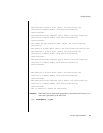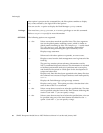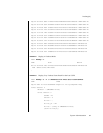
fmdump(8)
System Administration 59
The following are the Time Formats:
-u uuid Selects fault diagnosis events that exactly match the specified uuid.
Each diagnosis is associated with a Universal Unique Identifier
(UUID) for identification purposes. The -u option can be
combined with other options such as -v to show all of the details
associated with a particular diagnosis.
If the -e option and -u option are specified at the same time,
fmdump displays the relevant error events.
-v Displays verbose event detail. The event display is enlarged to
show additional common members of the selected events.
-V Displays very verbose event detail. The event display is enlarged
to show every member of the name-value pair list associated with
each event. In addition, for fault logs, the event display includes a
list of cross-references to the corresponding errors that were
associated with the diagnosis.
Time Format Description
mm/dd/yy hh:mm:ss Month, day, year, hour in 24-hour format, minute, and
second. Any amount of whitespace can separate the
date and time. The argument should be quoted so that
the shell interprets the two strings as a single
argument.
mm/dd/yy hh:mm Month, day, year, hour in 24-hour format, and minute.
Any amount of whitespace can separate the date and
time. The argument should be quoted so that the shell
interprets the two strings as a single argument.
mm/dd/yy 12:00:00AM on the specified month, day, and year
ddMonyy hh:mm:ss Day, month name, year, hour in 24-hour format,
minute, and second. Any amount of whitespace can
separate the date and time. The argument should be
quoted so that the shell interprets the two strings as a
single argument.
Mon dd hh:mm:ss Month, day, hour in 24-hour format, minute, and
second of the current year. Any amount of whitespace
can separate the date and time. The argument should
be quoted so that the shell interprets the two strings as
a single argument.


















